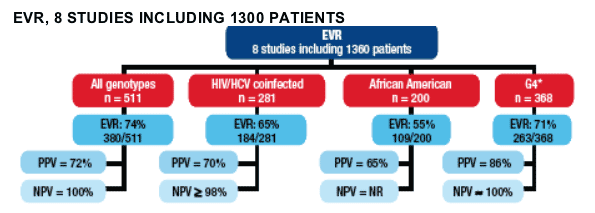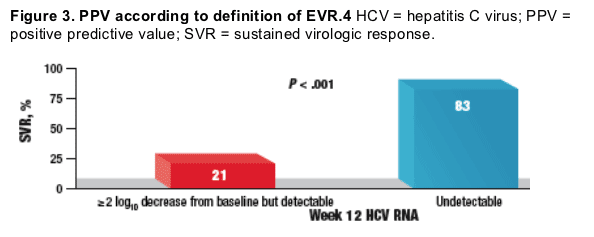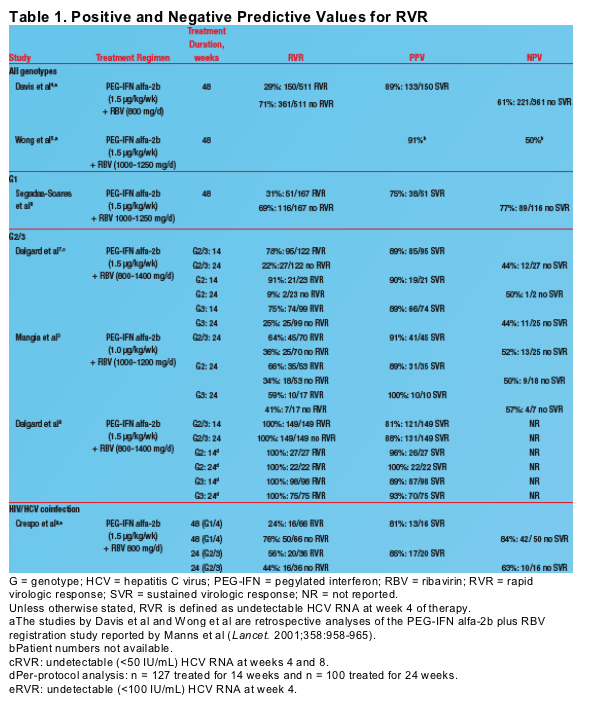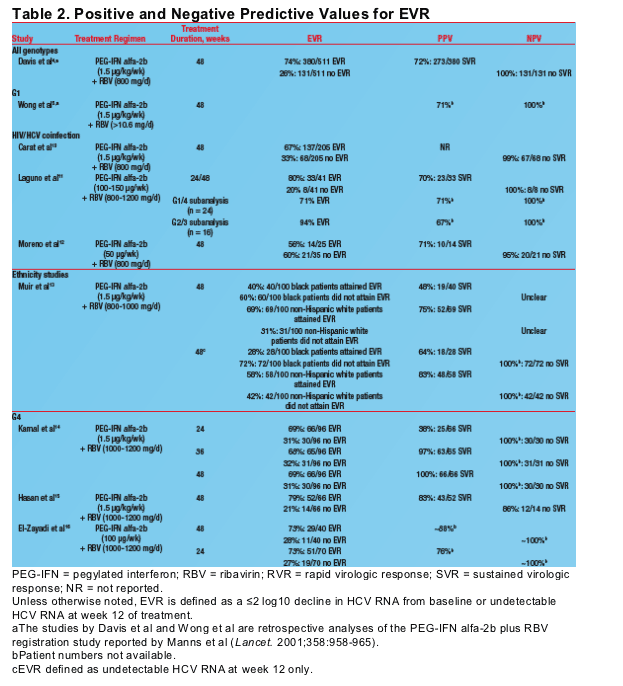 |
 |
 |
| |
Predictability of Response: Positive and Negative Predictive Values of Rapid and Early Virologic Responses to Peginterferon alfa-2b and Ribavirin in the Treatment of Chronic Hepatitis C
|
| |
| |
Reported by Jules Levin
AASLD, Nov 206, 2007, Boston, MA
Fred Poordad1 and Chrispin Kambili2
1Cedars-Sinai Medical Center, Los Angeles, California; 2Schering-Plough Corporation, Kenilworth, New Jersey
Conclusions
⋅ Among patients treated with PEG-IFN alfa-2b plus RBV, RVR (week 4 undetectable) has a high PPV for SVR
- Among G2/3 patients, attainment of RVR represents an opportunity to identify patients suitable for shortened treatment duration
- Attainment of RVR is an opportunity to motivate patients and can help reinforce adherence to their treatment plan
- The NPV of RVR (no RVR and no SVR) was generally low; therefore, RVR does not warrant consideration as part of a stopping rule
⋅ Among patients treated with PEG-IFN alfa-2b and RBV, EVR (week 12: 2 log reduction or undetectable) has a very high NPV (no EVR and no SVR)
- In patients for whom viral eradication is the sole aim of treatment, those who do not attain EVR should be withdrawn from treatment
⋅ The PPV of EVR for SVR is maximized when EVR is defined as undetectable HCV RNA at week 12
⋅ EVR is an important milestone in the treatment of many different patient types, including patients infected with HCV G1, African American patients, and patients coinfected with HCV/HIV
⋅ These results show that treatment with PEG-IFN alfa-2b predictably results in RVR, EVR, and subsequently SVR
Abstract
Background: Assessing viral kinetics in response to peginterferon (PEG-IFN) alfa and ribavirin (RBV) can help predict treatment response among patients with chronic hepatitis C. Hepatitis C virus (HCV) RNA levels decrease rapidly after initiation of treatment with PEG-IFN alfa-2b/RBV. To determine the value of assessing early viral kinetics during PEG-IFN alfa-2b/RBV therapy, positive and negative predictive values (PPVs; NPVs) of rapid and early virologic response (RVR; EVR) for sustained virologic response (SVR) were culled from PEG-IFN alfa-2b articles or abstracts.
Methods: Published PEG-IFN alfa-2b data were evaluated for PPVs and NPVs for RVR and/or EVR. PPVs and NPVs were calculated if not reported but RVR and/or EVR rates and SVR rates were available. RVR was defined as undetectable HCV RNA at wk 4 of treatment (lower limit of detection <50 IU/mL in most studies). EVR was defined as undetectable HCV RNA or a ≥2 log10 decrease from baseline at week 12 of treatment.
Results: Patients from applicable trials (N>2000) were monoinfected with HCV or coinfected with HCV/HIV and were treated with PEG-IFN alfa-2b (1.0 or 1.5 _g/kg/wk or 50-150 _g/wk) and various doses of RBV (800-1400 mg/d). Treatment duration was 48 or 24 weeks, generally depending on genotype (G).
Attaining RVR was highly predictive of attaining SVR in patients with any genotype who were treated for 48 weeks (PPV 89%), in G1/4 patients treated for 48 wks (PPV 81%), and in G2/3 patients treated for 24 wks (PPV 85-90%).
Not attaining RVR was a less reliable predictor of not attaining SVR for all genotypes (NPV 59%); NPVs were 84% among G1/4 and 44-63% among G2/3 patients. G2/G3 patients were analyzed separately in 1 study; the PPV and NPV for RVR were 89% and 50%, respectively, for G2 patients and 100% and 57%, respectively, for G3 patients.
Failure to attain EVR was a consistent indicator of failure to attain SVR (NPV 95-100%), whereas attaining EVR was a less reliable predictor of attaining SVR (PPV 67-72%) for all genotypes.
Among African Americans, NPVs and PPVs for EVR were 100% and 48-83%, respectively. Studies in G4 patients revealed NPVs for EVR of 86-100% and PPVs for EVR of 76-100%.
Conclusions: Predictability of response to PEG-IFN alfa-2b/RBV applied to mono- and coinfected patients. EVR was a better negative than positive predictor of SVR and can be used to guide treatment cessation in G1/4 patients who do not respond by week 12 of treatment. RVR was an excellent positive but poor negative predictor of SVR for all genotypes. RVR can be used as a patient motivator and can reliably be used as part of the treatment algorithm for future studies and in clinical practice.
RESULTS
Rapid Virologic Response
⋅ NPV and PPV values for RVR are presented in Table 13-9 and Figure 1
⋅ Overall, the NPV of RVR (no RVR and no SVR) was between 44%
and 84%
⋅ Overall, the PPV of RVR for SVR ranged from 75% to

Early Virologic Response
⋅ NPV and PPV values for EVR are presented in Table 24,5,10-16 and Figure 2
⋅ Overall, the NPV of EVR (no EVR and no SVR) ranged between 86%
and 100%
- For 11 of 13 report values, the NPV of EVR was 99% to 100%
⋅ The PPV of EVR for SVR varied widely according to the study population

Figure 1. Overall data summary. G = genotype; NPV = negative predictive value; PPV = positive predictive value; RVR = rapid virologic response. *North-C
study not included because attainment of RVR was basis of enrollment; Wong data not included because same cohort as Davis et al (both Manns' cohorts).

Figure 2. Overall data summary. G = genotype; NPV = negative predictive value; PPV = positive predictive value; RVR = rapid
virologic response. Wong data not included because same cohort as Davis et al (both Manns' cohorts). *24-Week regimens
excluded from G4 analysis due to clear lack of efficacy.

The PPV of EVR for SVR varied according to the definition of EVR (Figure 3)
- EVR defined as undetectable HCV RNA at week 12 had a significantly higher PPV for SVR than EVR defined as a ≥2 log10 decrease in HCV RNA from baseline, but with continuing detectability of HCV RNA (83% vs 21%, P < .001)4



|
| |
|
 |
 |
|
|